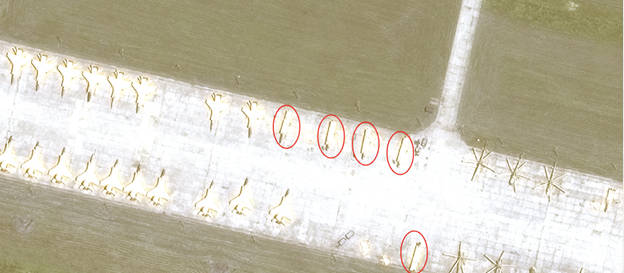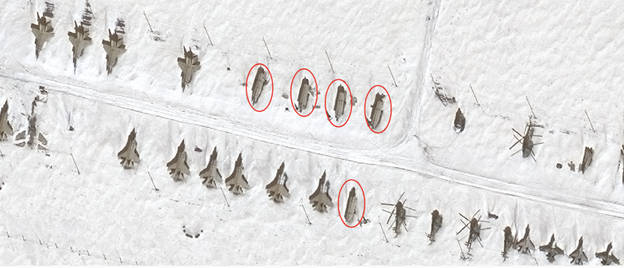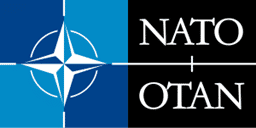The Impact of Sanctions and Alliances on Russian Military Capabilities
Sanctions have hindered Russia's military capabilities by raising procurement costs, increasing reliance on allies and straining its economy – despite Moscow’s evasion efforts.
This article addresses the disagreements surrounding the efficacy of sanctions regimes imposed on Russia by numerous countries. To achieve this aim, satellite imagery was purchased from Maxar through European Space Imaging (EUSI) and used in tandem with open source documents. Trade data, particularly for exchanges of microelectronics and weapons systems and platforms, was used alongside reporting by subject-matter experts. These sources helped me determine which countries acted as the main partners for Russia, and what this could indicate about the impact sanctions have had. The findings show that while Russia has been able to reroute microelectronics from the US and EU through regional allies (particularly Kazakhstan and China), this has raised the prices of supplies and components, which in turn has caused severe damage to Russia’s ability to properly maintain its military capabilities to the extent one would expect of a modern military superpower. Instead, it has been forced to prioritise the procurement and repair of armoured vehicles and drones, since these have proven to be more tactically relevant than its aircraft, which it has been unable to maintain sufficiently.
Data obtained from UN Comtrade shows trade patterns indicative of sanctions evasion; Kazakhstan, which serves as a regional strategic Russian ally, is a key player in routing export-restricted items (most notably semiconductors and other microelectronics) into the Russian economy. For instance, between June and July 2022, Kazakhstan’s exports of microelectronics (HS Commodity Code 8541) to Russia increased from $791,890 to $2,285,227. Pre-war monthly averages (January 2020 to January 2022) were $210,681; averages from February 2022 to February 2024 were $1,405,244, representing a 567% increase.
This raises the question of where Kazakhstan is obtaining the microelectronics. The answer, alarmingly, appears to be largely from Russian adversaries. Exports of these semiconductors from the EU were $719,977 in 2021, but rose sharply to over $4.1 million in 2022 (in 2023, they sat at almost $5 million). The UK displayed a similar trend, with 2021 export figures at $21,666, which increased by roughly 1,469% to $339,861 by 2022.
Far less surprising is the role that China has played in supporting Russia’s war efforts, without officially supplying it with munitions. Chinese exports of semiconductors to Russia rose by over $75.3 million from 2020 to 2023, demonstrating the “no-limits” partnership that the two countries announced 20 days before the 2022 invasion began.
These clear efforts to evade sanctions have permitted Russia to import the components needed by its defence sector, allowing for the expansion of relatively high-paying jobs producing, procuring and repairing the munitions, equipment and weapons platforms and systems that drive its war effort. This increased demand for high-paying labour has led to an impressive growth in real gross domestic product, with the Russian economy growing by 5.4% in the first quarter of 2024 compared to the same period of the year prior.
Russia isn’t solely relying on loopholes to avoid sanctions in order to prop up its defence procurement. Moscow has been relying heavily on its strategic partners and allies to support its war effort, strengthening ties and engaging in technology exchanges to assist in meeting the demands of its armed forces. According to Sipri, Russia ordered 7 Tiger AV armored patrol vehicles from China. According to the Financial Times, both Russia and China deny these transfers. An image that surfaced from the recent resurgence of conflict in Syria also suggests that China has supplied Russia with counter-UAV weapons systems (as seen below), damaging the credibility of its denials of aiding Russia’s war efforts.

Additionally, Iran has supplied Russia with ballistic missiles and Shahed 131 and 136 cruise missiles (along with their production licenses), as well as ~20 Mohajer-6 UAVs, which have proved crucial to filling the gaps in Russia’s domestic defence procurement. In return, there are strong indications that Viktor Bout has received the Kremlin’s blessing to supply arms to the Houthis, an Iranian proxy. Aid reciprocation has also come in the form of more standard arms transfers, such as several Su-35 and Yak-130 aircraft, together with Mil Mi-28 attack helicopters. Iran is also very likely taking advantage of the opportunity to test the effectiveness of its arms against Western systems.
Another crucial ally in Russia’s efforts to arm itself despite sanctions has been North Korea, which has drawn extensive attention with its contributions to the war in Ukraine. Since the start of the invasion in 2022, it has supplied Russian forces with an estimated 6 million artillery shells, five Hwasong-11 surface-to-surface missiles, and between 10–15,000 soldiers (estimates vary). Public reporting around the role and impact of these soldiers has been inconsistent and inconclusive. The most credible assessment is that they are unlikely to be used for front-line combat due to the small estimated number sent, the potential lack of training, and the language barrier between the North Koreans and their hosts. The quantity and quality of the troops sent to Russia would be highly unlikely to make a significant impact on the battlefield, and the language barrier would prove a hindrance to the efficiency and efficacy of force coordination on the front lines. It is therefore highly likely that the North Korean troops will be stationed either in such a manner as to free up Russian forces for transfer to combat areas, or behind the front lines in a defensive posture to act as a force multiplier in case of a Ukrainian offensive in that area. Russia, in turn, appears to have supplied its North Korean partners with Lancet UAVs and the licensing needed to produce them domestically.
On the one hand, it certainly appears as though the sanctions have very little efficacy, given how easily they are subverted by Russian allies. On the other hand, this subversion illustrates an important aspect that makes sanctions effective. For all intents and purposes, Russia is functionally cut off economically from the wider international community, instead being forced to rely on a small cadre of partners and satellite states to remain afloat. As mentioned earlier, defence procurement facilitated by Russia’s partners and allies has paved the way for large growths in economic output, but this growth highlights one potentially fatal flaw of a militarised economy: the risk of overheating, which could in turn lead to a collapse in political standing.
Thanks to the ongoing war, Russia’s economic output has been propped up by its defence spending, particularly because the government and industries are paying far above the normal market price for sanctioned goods. As such, a decrease in spending is very likely to cause a hike in unemployment, a drop in output, and a severe recession. Such a recession could have a destabilising effect on the Russian regime and the balance of power in the country.
Sanctions have achieved the crucial goal of leaving Russia’s economy highly unstable in the medium to long term, and heavily reducing its military capabilities to an extent that makes its current losses unsustainable
On top of this, the fact that the government and firms are having to pay more for goods due to sanctions has severely hampered their production capability. This means that even with foreign aid, there is a significant gap between the military’s needs and actual procurement. This is perhaps best illustrated by Russia’s announcement that it would be halting production of the Su-57, citing an inability to acquire the parts needed to maintain the aircraft. Instead, it will be focusing on older platforms like the Su-35. On top of this, the Kremlin’s announcement that the state-owned film studio Mosfilm would transfer ownership of its T-55 and PT-76 tanks (which were first manufactured in the 1950s) further highlights the gap between needs and production capability caused by sanctions.
To support the analysis, imagery was taken from four Russian air bases (Engels 2, Buturlinovka, Perm and Lipetsk) for the period between 2021 and 2024. Two significant trends appeared; the first, and arguably more significant, was that many aircraft remained in a static state of disrepair. The other, more ambiguous trend was that there was little to no clear change in raw operational craft numbers or infrastructure.
As discussed in the previous section regarding trade data, Russia has had difficulties replacing and maintaining vehicle numbers, instead relying on its strategic partners to make up for its unsustainable losses. At the operational and tactical level, this procurement gap has manifested in soldiers making use of substandard munitions (particularly North Korean shells) and outdated weapons platforms and systems (such as the T-55). The heavy losses have also had strategic implications, including rendering the Russian regime unable to assist partners – most notably the former Assad regime in Syria, which received little substantive aid from Moscow prior to its fall.
The inability to maintain vehicles can be seen clearly in the satellite imagery provided by EUSI/Maxar. Data on the air bases was relatively easy to obtain and analyse due in large part to the Russian doctrine of keeping flight lines in the open. The Lipetsk air base offers the most glaring example of unmaintained craft.


The static state of the visually decrepit aircraft should be indication enough of the priorities of the Russian Ministry of Defence, with resources seemingly being allocated towards UAVs, armoured vehicles (including infantry fighting vehicles [IFVs], armoured personnel carriers , and tanks) and artillery, all of which have proven to be more tactically relevant than traditional air dominance; while aircraft have played a role, air power has for the most part been defined by UAVs. It remains to be seen how counter-UAV systems develop, and how these might change the dependence on drones. It is, however, highly likely that aircraft maintenance will remain on the backburner, as drones are relatively cheap and resource-efficient weapons platforms, especially given the low resource input of both Ukraine and Russia. The figure below illustrates the roughly 15% gap between production/reactivation and losses, despite the prioritisation of IFVs.
Between 2021 and 2023, no significant development was seen in the areas of interest, with little to no infrastructure change being observable. Roughly the same can be said for raw numbers of craft; this, as mentioned earlier, is a bit harder to assess, and some slight change can be seen, but overall, the number of aircraft visible remained fairly stable. The largest decrease in numbers over time can be seen in Lipetsk, with an overall decrease of 41 between 2021 and 2024 (a loss of 46 Mig-21 planes made up the majority of this fall, with this number being balanced out by the addition of 27 Su-30 planes). This stagnation of infrastructure and slight decrease in craft numbers strongly reinforces the perception that sanctions regimes have severely impaired Russia’s ability to cement air dominance during the war, and lends further credibility to the idea that resource shortages have placed its air force further down the hierarchy of priorities than was expected in the run-up to the 2022 invasion.
Sanctions have proven to be highly effective at raising the price of the materials needed to maintain a modern fighting force, thereby increasing Russian reliance on partners to supply weapon systems and platforms that one would expect to be available in abundance within a modern military superpower. While sanctions have failed to fully stop imports and transfers of supplies, this was always inevitable (see: North Korea and Iran), but they have achieved the crucial goal of leaving Russia’s economy highly unstable in the medium to long term, and heavily reducing its military capabilities to an extent that makes its current losses unsustainable.
© Oliver Ruth, 2025, published by RUSI with permission of the author
The views expressed in this Commentary are the author’s, and do not represent those of RUSI or any other institution.
For terms of use, see Website Ts&Cs of Use.
Have an idea for a Commentary you’d like to write for us? Send a short pitch to commentaries@rusi.org and we’ll get back to you if it fits into our research interests. Full guidelines for contributors can be found here.
This research project has been funded by the North Atlantic Treaty Organization

WRITTEN BY
Oliver Ruth
- Jim McLeanMedia Relations Manager+44 (0)7917 373 069JimMc@rusi.org


